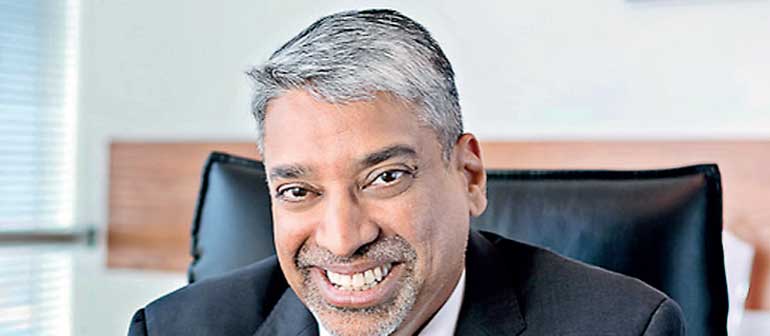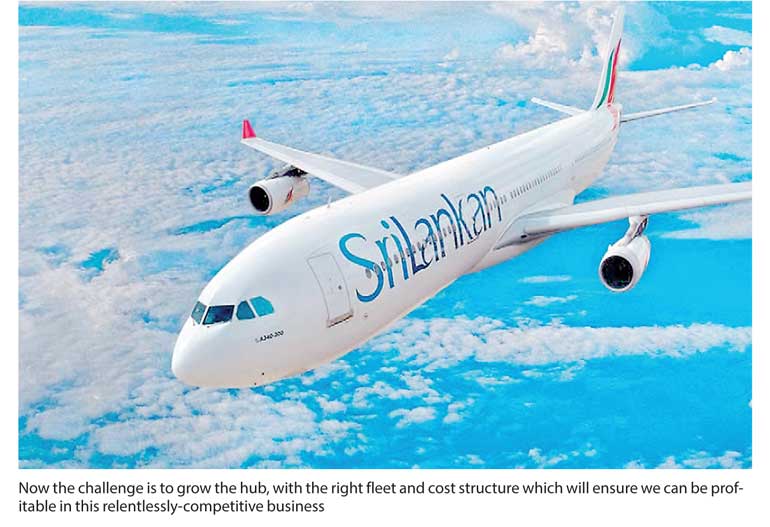Wednesday Mar 12, 2025
Wednesday Mar 12, 2025
Wednesday, 20 December 2017 00:01 - - {{hitsCtrl.values.hits}}

 By Capt. Suren Ratwatte
By Capt. Suren Ratwatte
We started the year with a challenge that the airline had never faced before – the closure of the only runway at Colombo’s Bandaranaike International Airport for much needed resurfacing. The eight-hour daily closure over 90 days meant that the airport had to accommodate 24 hours of operations in 16 hours.
The greatest challenge of this was for SriLankan as it meant that we had to cancel a large number of flights – over 600 in the three-month period – in order to fit into the reduced operational period. Needless to say, this resulted in a major loss of revenue. It also brought about cost complexities, as we had high cost assets – aircraft and crew– being underutilised due to the cancellations. We realised from the beginning that conducting smooth operations during this period would require an extraordinary effort.
The onus was on SriLankan’s Ground Services division – which had to ensure that not only our own, but also all other airlines’ flights were serviced and that they departed on time. The teams worked around the clock to make all necessary preparations. As a result of adequate pre-planning and proactive management, SriLankan was able to conduct a very smooth operation during this period – for itself and all airlines serving Colombo – with nearly 100% punctuality. However, the reduction in operations resulted in a severe loss of revenue which marred what could have been a stellar financial year for us.
The major achievement of the year was the validation of the ‘Colombo Hub’ concept. As part of this strategy, SriLankan implemented one of the biggest expansions of its route network in recent years – with the introduction of services to three new destinations, namely, Hyderabad, Coimbatore and Visakhapatnam in India, and the launch of direct non-stop services to existing destinations of Guangzhou and Hong Kong.
This marked two key milestones, achieving firstly the highest number of destinations in the history of any Sri Lanka-based airline, and secondly, SriLankan becoming the foreign airline to serve the most number of destinations in India. This is all part of our vision to transform the airline into a regional powerhouse, serving a market that has the potential to be the world’s largest.
The strategy of becoming a key player in the South Asian region took another major step ahead when the airline launched daily nonstop services to Melbourne, Australia, in October. This marked the first time that direct air links were established between Sri Lanka and Australia after a hiatus of 16 years.
Apart from creating business links, this move is expected to greatly contribute towards an influx of Australian tourists to Sri Lanka. The results are already bearing fruit, with the tourist arrivals from Australia up by 23.7% in the month of November alone. Healthy sixth freedom traffic to major Indian metros further confirms the use of Colombo as a key hub to the sub-continent.
Further validation of our niche “boutique airline” status took place with SriLankan being bestowed the prestigious World Travel Awards 2017’s ‘Best Airline to the Indian Ocean’ award in early December. This marks the first time we have won a global award and shows not only the commitment and enthusiasm of our team members, but also the huge potential we have to dominate our regional space.
Now the challenge is to grow the hub, with the right fleet and cost structure which will ensure we can be profitable in this relentlessly-competitive business. Low cost carriers are the main players in this region and we too must become leaner and more efficient if we are to compete effectively with them. Sri Lanka’s main inbound tourism sources, China and India, are primarily served by the national carrier. With the direct Melbourne flight adding a new dimension to these markets, we continue to be the major source of tourists to the country. But threats abound, not only from the LCCs who continue to add capacity while pushing down ticket prices, but also the Gulf carriers who seek more connecting passengers for their “mega-hubs”
During the year, the airline also took steps to renew its fleet with modern fuel-efficient narrow-bodied aircraft. The first Airbus A320neo aircraft – delivering 15% efficiency in fuel burn over the older A320 aircraft – joined the fleet in February.
In 2017, we have taken delivery of two A320neo aircraft and three A321neo aircraft – putting us on track to become the first Asian airline to operate the latter type. These aircraft are perfectly suited for our new strategy, focused on building regional strength. They will continue to serve SriLankan’s needs well over the next several years and be an important pillar of our future operations.
Even as our revenues have grown – the airline is on track to be a billion dollar company this financial year – our cost base has remained untrimmed over the years. In a market where the yields remain poor, but fuel prices are rising, this is no longer tenable. Reducing our costs while maintaining our standards and not compromising on the product, is a huge challenge that we must all focus on. The focus for 2018 must be consolidation and transformation. Our shareholder, the Government of Sri Lanka, has recognised the need for the airline to restructure, as the burden on the national economy will become unbearable unless losses are contained. To this end, the services of world-renowned consultant to assist the management in this task has been secured. The consultant’s brief covers not only the restructuring of the company but also the search for an equity partner, be it an airline or an investment entity, who will invest in the airline and this bring in much-needed capital and management experience to the table. The high lease costs of our fleet is something the consultant will assist us in addressing. The Government is committed to solving the cost of capital and the interest cost of our debt. Reducing our corporate costs and transforming ourselves into a much leaner, fitter and more nimble airline, which can respond quickly to changing market forces, is a task we must accomplish ourselves. Once these issues are addressed, we will be in a position to start growing again and assert our role as a major player in the Indian Ocean arena.
Looking forward to an exciting and transformational 2018.
(The writer is Chief Executive Officer of SriLankan Airlines.)
Discover Kapruka, the leading online shopping platform in Sri Lanka, where you can conveniently send Gifts and Flowers to your loved ones for any event including Valentine ’s Day. Explore a wide range of popular Shopping Categories on Kapruka, including Toys, Groceries, Electronics, Birthday Cakes, Fruits, Chocolates, Flower Bouquets, Clothing, Watches, Lingerie, Gift Sets and Jewellery. Also if you’re interested in selling with Kapruka, Partner Central by Kapruka is the best solution to start with. Moreover, through Kapruka Global Shop, you can also enjoy the convenience of purchasing products from renowned platforms like Amazon and eBay and have them delivered to Sri Lanka.
Discover Kapruka, the leading online shopping platform in Sri Lanka, where you can conveniently send Gifts and Flowers to your loved ones for any event including Valentine ’s Day. Explore a wide range of popular Shopping Categories on Kapruka, including Toys, Groceries, Electronics, Birthday Cakes, Fruits, Chocolates, Flower Bouquets, Clothing, Watches, Lingerie, Gift Sets and Jewellery. Also if you’re interested in selling with Kapruka, Partner Central by Kapruka is the best solution to start with. Moreover, through Kapruka Global Shop, you can also enjoy the convenience of purchasing products from renowned platforms like Amazon and eBay and have them delivered to Sri Lanka.